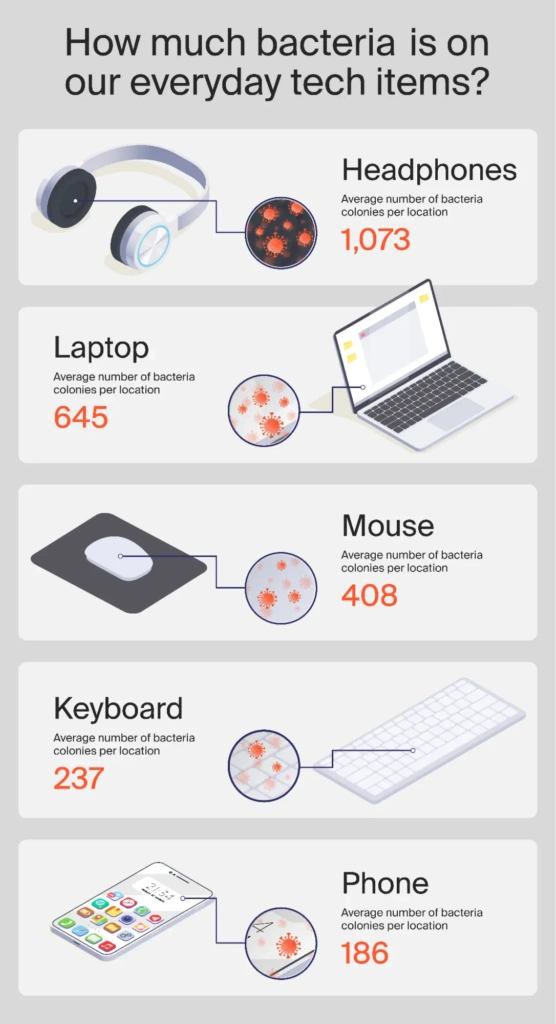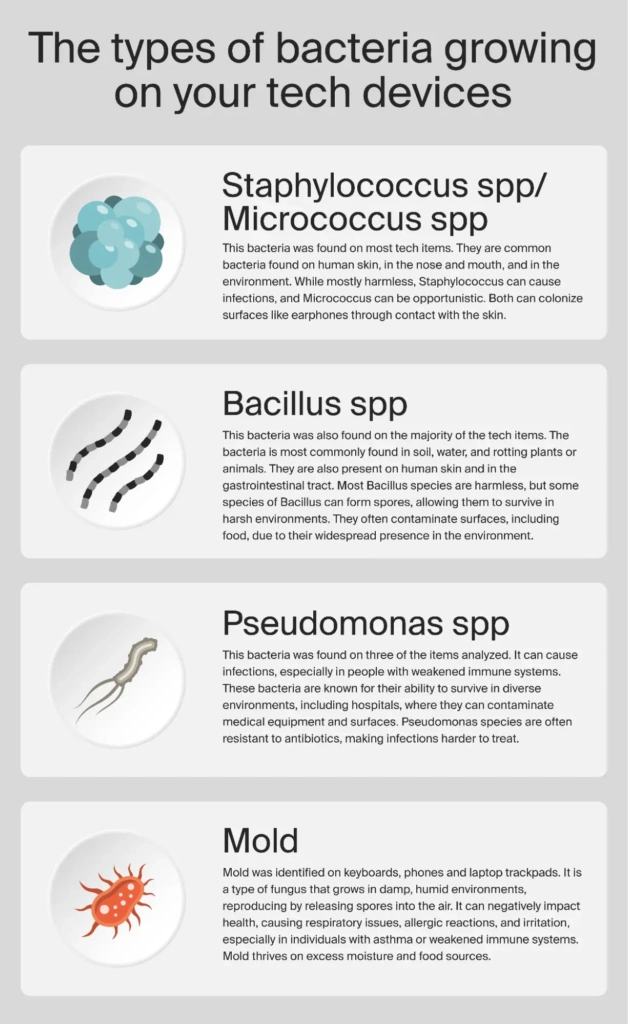We take our phones and tech devices everywhere — whether it’s on the train, at a coffee shop, or even in bed, we’re rarely far from them. In fact, 75% of Americans admit to using their phones even while on the toilet.
With each new location, our devices pick up a mix of dust, dirt, and germs along the way. While the COVID-19 pandemic may have heightened our awareness of germs, are we paying enough attention to the bacteria that can gather on our everyday gadgets?
To determine how much bacteria accumulates on our devices, we swabbed mobile phones, laptops, headphones, keyboards, and computer mice. These samples were sent to a lab for analysis to identify the number of microbes present on our everyday tech gadgets. The results were then compared to the bacteria levels on toilet seats, trash cans, and public transport surfaces.
In light of our findings, we’ve also spoken to Dr. Maria Knobel from Medical Cert on the importance of keeping your mobile phone and other tech devices clean and how often we should be cleaning them.
Our Study Reveals There Are Thousands Of Bacteria Living On Our Everyday Tech Devices
In our tech-driven world, we may often overlook the surprising amount of bacteria lurking on the devices we use daily. From headphones to laptops, these seemingly innocuous gadgets can harbor alarming levels of microbial life.

1. Headphones
Of all the devices swabbed for bacteria, headphones presented the most, with an average of 1,073 colonies growing. For some headphones, this number increased to above 3,000 colonies. This is over twice as dirty as a toilet seat, which typically has around 425 bacterial colonies on average.
In fact, the average number of bacteria on headphones is close to the 1,100 colonies found on a trash can. Compared to the handle of a public bus, which hosts 190 colonies, headphones are over five times dirtier.
Whether you’re wearing them for your commute to work or at the gym, sweat and heat can accumulate, providing the perfect breeding grounds for bacteria.
2. Laptop
Whether it’s your work laptop or personal one, it is a device most people use daily, often for hours at a time and in various locations — ranging from the office to coffee shops and public transport.
On average, 645 colonies of bacteria can be found on a laptop, and for some users, their device harbors over 3,000 colonies. That’s just over seven times dirtier than a toilet seat and more than twice the number of bacteria found on a trash can.
Mold was most commonly found on laptops, thriving in damp, humid conditions and reproducing by releasing airborne spores. This can cause respiratory issues, especially for individuals with asthma. It also thrives on excess moisture and food, so be aware the next time you eat around your laptop.
3. Mouse
Your computer mouse is only marginally cleaner than your laptop. During the experiment, an average of 408 bacteria colonies were present on swabs from computer mice, with some showing over 3,000 colonies.
4. Keyboard
With the amount of hidden spots for bacteria to form, it’s unsurprising that keyboards make the list. With an average of 237 bacteria colonies, however, your keyboard is likely cleaner than a toilet seat, but still dirtier than a public bus handle.
However, some keyboards came back with up to 970 colonies, making them twice as dirty as a toilet seat, so make sure to thoroughly clean your keys.
5. Mobile phone
Despite picking them up around 144 times a day, mobile phones came up as the cleanest device in the experiment. However, the data still showed an average of 187 bacteria colonies, making the average phone just as dirty as the handle of a bus in the city. The dirtiest phone was host to 1,130 colonies, making it dirtier than a public trash can.
We press our mobile phones to our faces daily. Even if we’re not making calls, we swipe and tap around 2,617 times a day, transferring bacteria from the screen directly to our skin.
What Types Of Bacteria Are Found On Tech Devices?
If knowing how much bacteria is living on our devices wasn’t disturbing enough, we have also found the different types of bacteria we’re most likely to find on our devices. Not only was bacteria found, but also mold. Electronics can get warm, and combined with your natural body heat, this forms the perfect conditions for mold to grow.

1. Staphylococcus spp / Micrococcus spp
This bacteria was found on most tech items. They are common bacteria found on human skin, in the nose and mouth, and in the environment.
While mostly harmless, Staphylococcus can cause infections, and Micrococcus can be opportunistic. Both can colonize surfaces like earphones through contact with the skin.
2. Bacillus spp
This bacteria was also found on the majority of the tech items. The bacteria is most commonly found in soil, water, and rotting plants or animals. They are also present on human skin and in the gastrointestinal tract.
Most Bacillus species are harmless, but some species of Bacillus can form spores, allowing them to survive in harsh environments. They often contaminate surfaces, including food, due to their widespread presence in the environment.
3. Pseudomonas spp
This bacteria was found on three of the items analyzed. It can cause infections, especially in people with weakened immune systems.
These bacteria are known for their ability to survive in diverse environments, including hospitals, where they can contaminate medical equipment and surfaces. Pseudomonas species are often resistant to antibiotics, making infections harder to treat.
4. Mold
Mold was identified on keyboards, phones, and laptop trackpads. It is a type of fungus that grows in damp, humid environments, reproducing by releasing spores into the air.
It can negatively impact health, causing respiratory issues, allergic reactions, and irritation, especially in individuals with asthma or weakened immune systems. Mold thrives on excess moisture and food sources.
How To Reduce The Amount Of Bacteria On Your Devices
Even the ‘cleanest’ item, a mobile phone, still harbors an average of 187 colonies of bacteria. So, you might be wondering how you can keep your devices clean. Below are some simple steps to ensure your devices stay squeaky clean.
1. Turn off the device
Cleaning will usually involve an element of liquids being near your device. Always turn off or unplug any tech device before cleaning to avoid any accidental damage or short-circuiting of the item, allowing 30 minutes before turning the device back on.
2. Use soft cloths
The FCC suggests using a ‘lint-free cloth slightly dampened with soap and water’ when cleaning. Microfiber cloths are gentle on surfaces and effective at picking up dust and bacteria without scratching.
3. Avoid harsh chemicals
Stay away from cleaning solutions containing bleach or abrasives as these could damage your items. Instead, The Centers for Disease Control and Prevention suggests alcohol-based wipes or sprays containing at least 70% alcohol to successfully disinfect your screens and devices.
4. Dislodge keyboard debris
Dirt and crumbs can become lodged underneath keyboard keys, making a perfect breeding ground for mold and bacteria.
By turning the keyboard upside down and gently shaking, this can dislodge the debris. Spraying compressed air can then blow out any remnants left, leaving only a wipe-down of the keys to fully clean your keyboard.
5. Remove your phone case
Your phone case may protect the body of your phone, but it can also collect a lot of bacteria. A plastic case is relatively durable, so it can survive tougher cleaning solutions.
Rubber or silicone will need milder cleaning products to avoid damage, and for those with leather cases, even more care may be required. Leather cases will absorb water, making it the preferable environment for bacteria.
So, it’s wise to use as little water as possible, making the cleaning cloth slightly damp using lukewarm water and hand soap.
6. Dry thoroughly
Bacteria thrives in moist environments, so make sure you dry any device after cleaning with liquids. Place the item in a well-ventilated area to air dry and make sure it’s positioned in a way that allows the air to circulate. For example, propping your laptop at a 90-degree angle to dry will let the air reach all areas.”
Health Expert Shares The Importance Of Daily Cleaning Of Tech Devices
Dr. Maria Knobel, Medical Director of Medical Cert UK shares the importance of cleaning your tech devices:
“Tech devices, like smartphones, are touched frequently and placed on various surfaces — desks, counters, public transport, and bathrooms — collecting germs that easily transfer to our hands and face. For example, using a phone while eating, placing it on the gym floor, and later holding it to your face leads to an accumulation of bacteria, dirt, and oils.
“Devices should be cleaned daily to minimize the risk of infections like colds, flu, or acne, especially for those with active lifestyles who regularly expose their phones to different environments. A microfiber cloth and electronic-safe disinfectant help remove harmful buildup, reducing the chance of transferring germs.
“During cold and flu seasons, tech devices can harbor viruses for up to 24 hours, increasing the risk of transmission. Regular cleaning is crucial, particularly if devices are shared with others, to prevent the spread of germs at home or work.”
Methodology
CloudZero conducted a scientific experiment to determine how much bacteria can be found on everyday tech devices. They swabbed 38 devices from various participants and sent the samples to a microbiology laboratory.
Some results had too many colonies and they were unable to be counted exactly. In this case, an approximate figure of “3,000+” was used. Swabs were also conducted and sent to the lab of a toilet seat, toilet handle, a public bus handle, and a public trash can for comparison.







